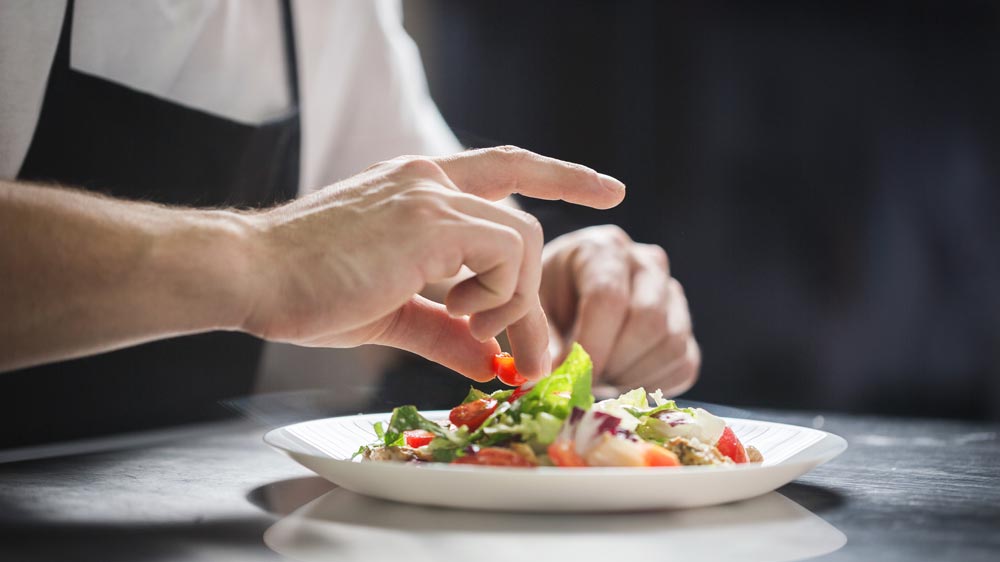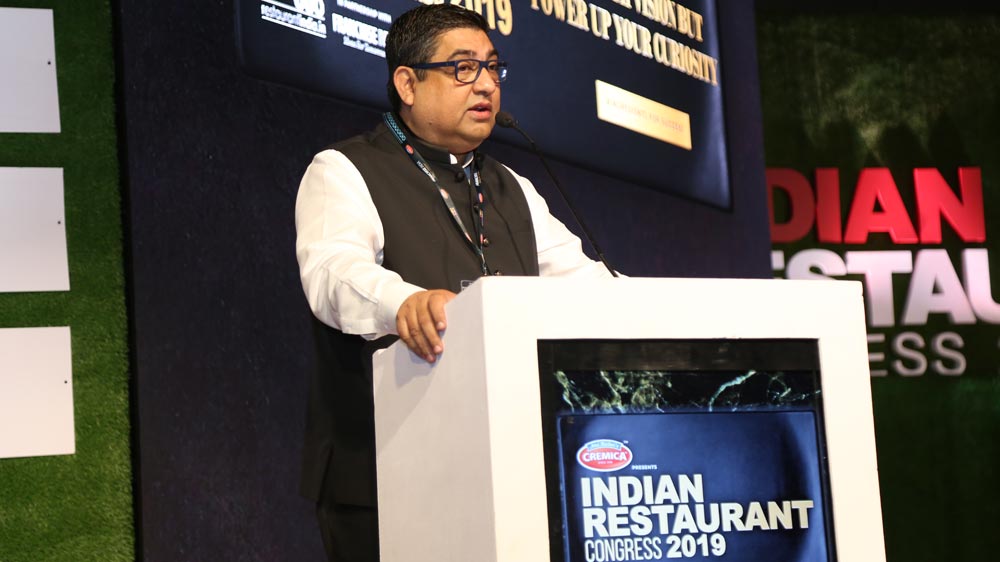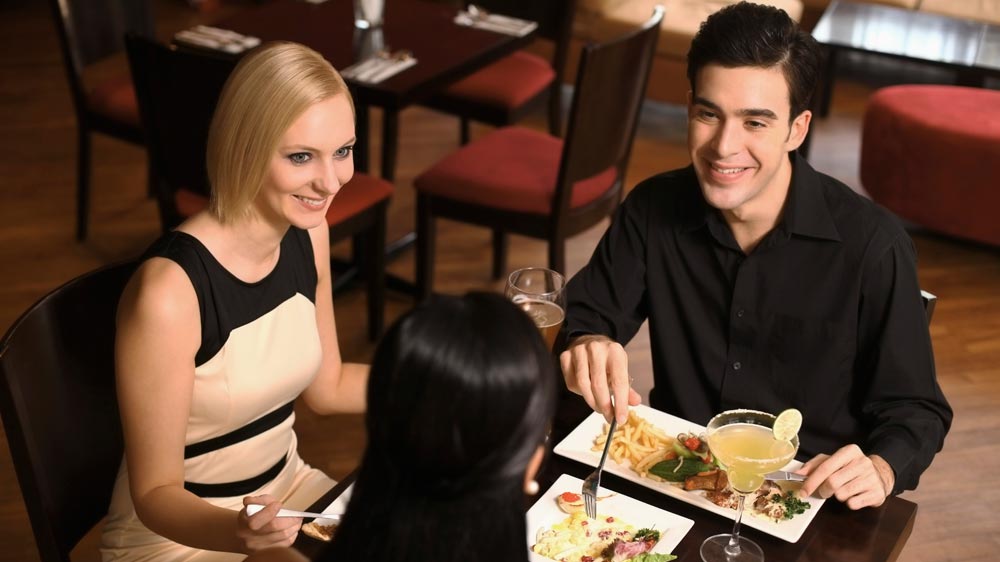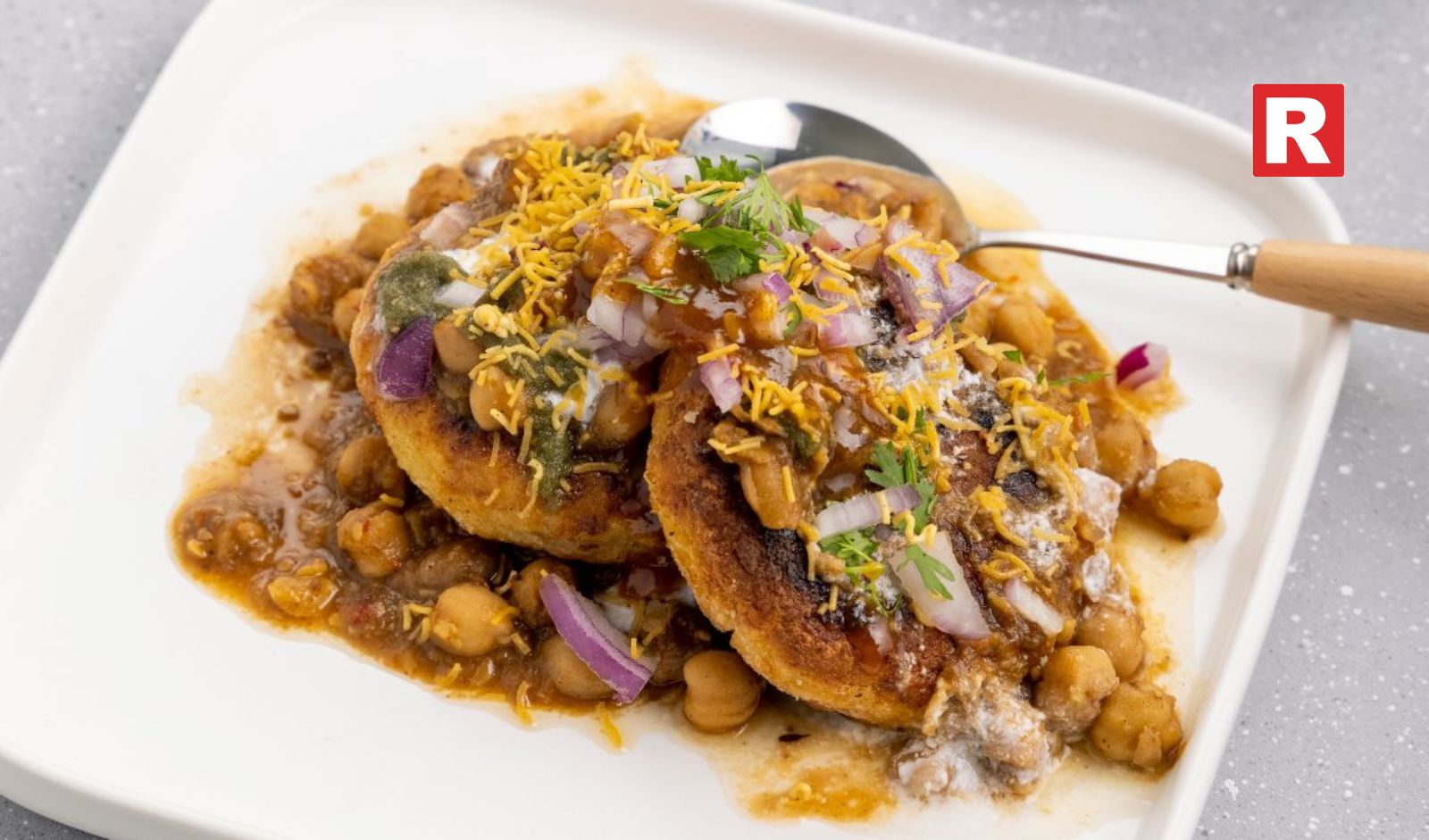
The Japanese restaurant YOÜMEE has launched an all-new scrumptious menu. Here is a review of some of their specialities that we tried and found amazingly unconventional
The capital city, New Delhi, has lately been a witness to the establishment of a lot of pan-Asian restaurants, which reflects a trend of sorts. Some of them are thriving with their small loyal customer base by offering a unique experience of authentic yet delectable dishes, while a few of them are straggling behind. Adding to this interesting and emerging culinary landscape is YOÜMEE, an Asian cuisine restaurant inspired by Manga, the Japanese-styled comics. Its menu is a blend of the multicultural influences drawn from Southeast Asia – the food being a window to what is available in those regions. Curated by Head Chef Rattan Kumar, the expansive menu is a mix of ramen, noodles, dumplings, prawn tempura, sushi platter, rolls, meal bowls, etc., in addition to desserts.
Giving its own twist to tapas, which is an appetiser in Spanish cuisine, with a Japanese inspiration, the restaurant has introduced ‘japas’ to offer the best of both worlds. One can relish a range of japas dishes such as Pumpkin Karaage, Chicken Star Anise with Crispy Horenso, Tobiko Gunkan and Tuna Truffle Tartare, to name a few. The ramen section has mouth-watering additions such as Kimchi Ramen, YOÜMEE Veggie Signature Ramen, Salmon Ramen and Chicken Meatballs Ramen. For mains, there is the unique set of bowl meals – either served assembled or deconstructed with assorted flavours such as Thai Style Basil Vegetables, Tofu Teriyaki Don, Chilli Bean Fish Fillet and Three Pepper Chicken.
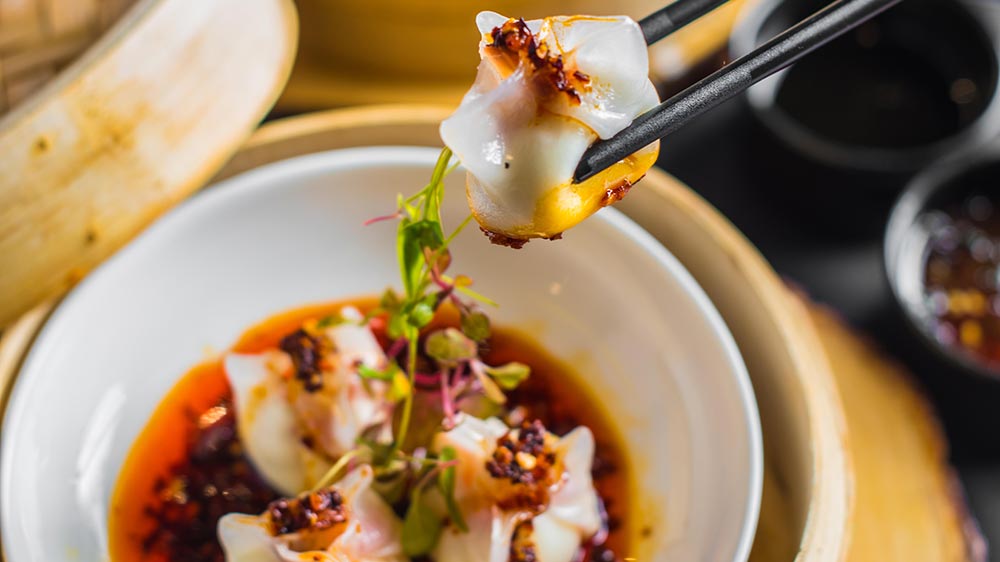
We started off with a vegetable sushi platter, which came with three different types of sushi. The avocado and mango black rice sushi with cream cheese had a refreshing taste to it, resembling a work of art on our plates. We loved the assimilation of mango avocado and cream cheese. Fitness mavens can enjoy the black rice sushi, which will make their indulgence healthier. Next we had the Thai-flavoured asparagus and their signature New York cheese with chilli oil dimsums. We absolutely fell head over heels in love with this dish. The cheese just melted in our mouths with a subtle flavour of chilli oil. It was not any less than heaven and we recommend it strongly for all those who love cheese.
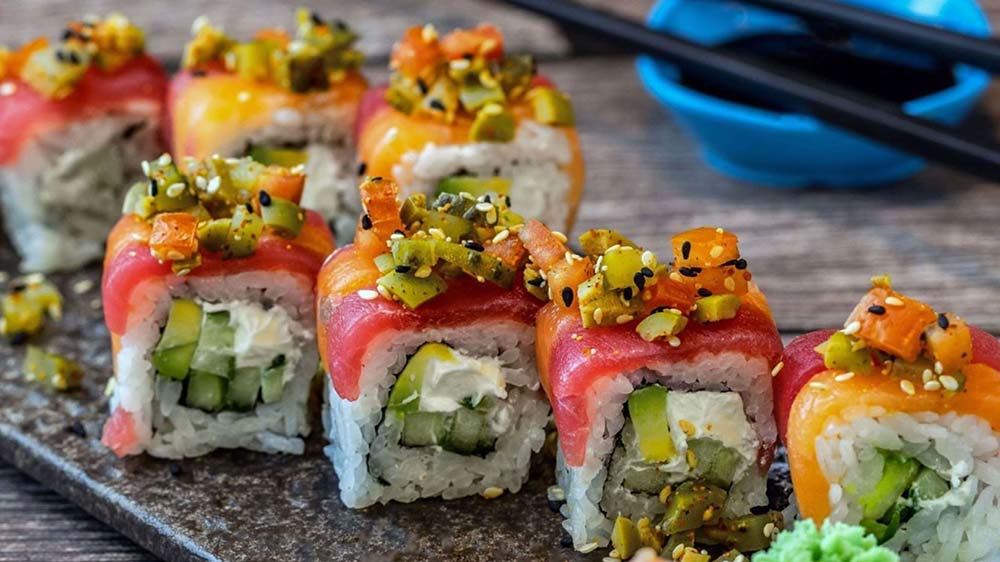
However, the dessert part of this food exploration did not live up to our expectations. We had honey toast, which had ice cream and dry fruits in it. It just did not make the cut. But rest assured, YOÜMEE did offer an unconventional dining experience that transported us from the smog-choked city to the bustling and vibrant region of Southeast Asia. As an aside, let us mention that Manga comics have a cult following across the world, where the kitchen is turned into a backdrop for romance, comedy, and intrigue. Like the cooking manga, YOÜMEE is a reflection of an overall cultural interest in food and cooking. The place is not just about fiery battles and the story; it is about the language of vegetables, meat, spices, and herbs.
Also read:
How Asian food is heating Indian food space

Covid-19 pandemic has changed everything about food. From the way people have been consuming food in last six months to the way we have seen restaurants and food companies selling their food and food products. Last year, we have seen more and more people adopting healthy living style by focusing more on local, regional and plant-based products. Mock meat has also seen a growth not just in India but also at global level. International chains like Burger King, McDonald’s have experimented their menu with plant-based patty etc.

With coronavirus pandemic the whole equation of the restaurant business changed where people are now looking at immunity-boosting, short and crisp menu. Technology has gone way ahead when it comes to food business. Not just ordering your favourite food, it has also become paying through wallets etc and adoptiong a cashless transactions.
Also Read: 5 Food Trends that will rule restaurants post covid
The menus would be digital: Since, digital is the new buzzword, from placing your orders online to scanning food through a digital menu would be the biggest trend post covid.
Payments will go digital: With more and more people wanting to go cashless, digital payments remains the safest options for anyone paying the bills.

Incorporating service changes: From the service point of view, earlier a physical person would do the service, but now that would be replaced with technology. You would not need a server to serve you at the table. Instead, technology would do all the work. In fact, if we see at some of the global restaurants, they already have robot as a server now.
Focus will be on hygiene: Going forward, people will be more concerned about safety and hygiene. They will expect more hygiene and sanitization at the restaurant when they are eating out or when they are ordering something on-the-go.

Fresh is in demand: It is always believed that fresh and local ingredients are good for both restaurants and its customer. For restaurants it shortens the cost involved in supplying those materials plus they also tend to promote local businesses. Wheres, eating local and fresh keeps customers healthy. Hence, restaurants should not compromise on fresh food, because the safety of the customer is very important.
May Interest: Domino's introduces cashless payment option for customers
Not sharing is caring: As everyone is looking at their own safety, 2020 and the coming years would be focused on not sharing your food with anyone. Restaurants will have more compact, smaller menus to showcase to the customer.

Pa Pa Ya, the modern Asian bistro from the House of Massive Restaurants, has launched an extensive Sushi menu featuring over 45 different variations of Sushi, including the complex Nigaki, making it the only place in India to serve it. Chef Sahil Singh, Corporate Chef, Massive Restaurants has curated this exclusive Sushi menu, to take one on a culinary journey through the landscape of Asia.
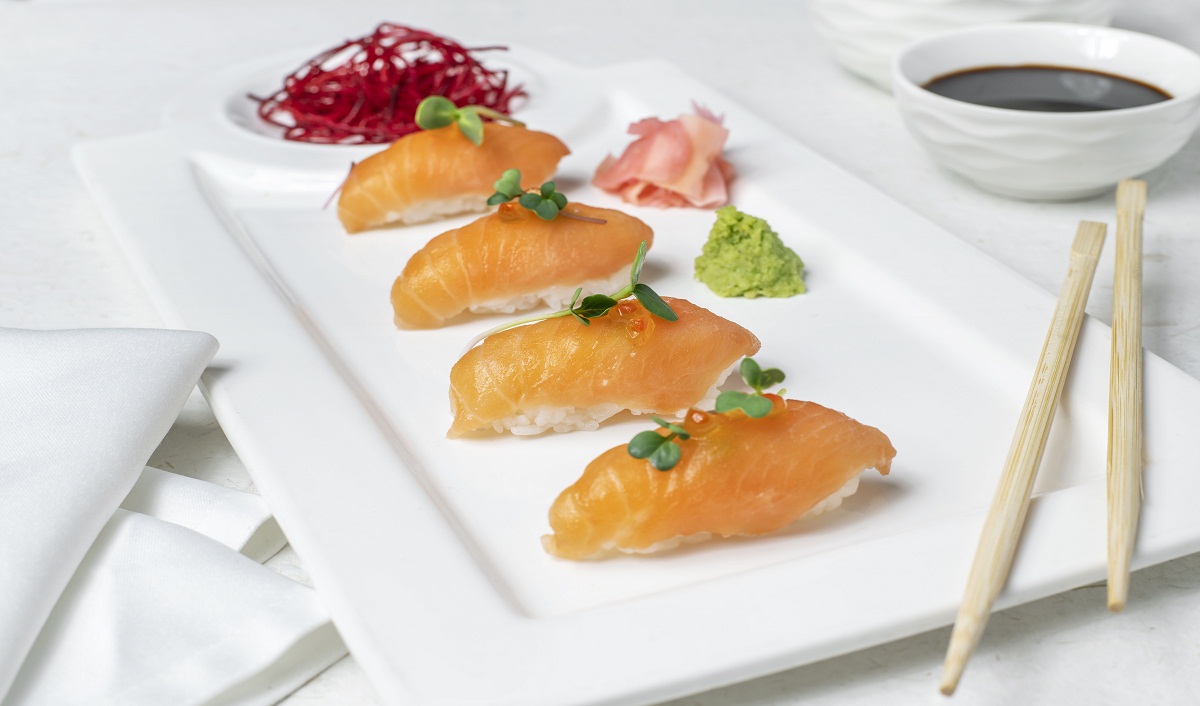
Some of the signature Sushis from this new menu include: Ama Ebi Sashimi (thinly sliced shrimp), the crowd favourite - Spicy Avocado Sushi Roll (rice paper rolls served with seasoned creamy avocado), Salmon and Scallop Firepit Smoked Ikura (salmon and salmon roe wrapped in cucumber slice and flambéd), Fruits De Mer Xo ( tempura fried prawn sushi,), Yasai Nigaki (vegatarian nigaki, which contains asparagus, shitake mushrooms, sriracha caviar, bubuare and yuzu mayonnaise) and Layered Sushi Pizza Zucchini Carpaccio ( Sushi Rice, Zucchini Carpaccio steamed Edamame, fresh veggies and ginger Tamari roll).

We started off with the new vegetable sushi menu. We were presented with Spicy Avocado and Asparagus Tempura Rolls platters. The sushi had a refreshing taste to it and wasn’t in a typical cube shape. Other varieties of sushi we tried were Crispy Vegetable Maki Dehydrated, Sushi Burger (pickled vegetables Philli Aioli), Layered Shushi Pizza Zucchi Carpaccio and Nigaki- California Roll. Among these sushis, we absolutely fell head over heels in love with their Dehydrated Maki Sushi, which has dehydrated spinach on it. Not only was it crispy but was also just delightful to eat. However, we did not like the Sushi Burger, therefore would not recommend it. Over all it was like a scrumptious veg sushi feast.
Massive Restaurants is spearheaded by Zorawar Kalra and mentored by his illustrious father and Czar of Indian Cuisine – the Late Jiggs Kalra. The Company currently operates under brand verticals of premium Fine-Dining Restaurants like Masala Library by Jiggs Kalra, the Smart-Casual Dining Restaurants with the brand name Made in Punjab, the modern Indian bistro concept Farzi Café and modern pan-Asian bistro concept Pa Pa Ya.

Gastronomy is an art to produce and present food in an innovative and unique style which delights the client that top restaurants are ready to deliver with a pleasant tasting experience by offering a variety of options that suit the mood and taste of each guest, from a romantic dinner to a convivial meal with family and friends. Similarly, we look forward to organizing a memorable dinner occasionally at our Vegas (All day Dining) and Emperor (Oriental specialty restaurant) or in the state of grace, in the heart of our lovely pool garden, this possibility is just on prior request.
Introducing Contemporary Fusion
Restaurants today focus on menu based on the guiding principles of natural ingredients, local and sustainable that is helping guests to reconnect with food safe in the knowledge that it’s good for health, and good for the world around. The menu is crafted with few dishes having balance components & light in by combining contemporary interpretations. At Deltin Daman one will be served with a refined delicacy and well-being of fusion-inspired flavors. Contemporary fusion may also mean going a step further and adding new ingredients to give value to the finished product or using healthier methods of cooking – grilling instead of frying or working towards a baked version. The word “contemporary” is also used by some chefs to denote a process called “deconstruction.”
Asian Food is on Menu
Restaurants these days are focusing a lot on the Asian delicacies. Similarly, at Emperor which is an in-house restaurant at Deltin, the chefs revive the traditional Asian Street food. A special menu is crafted by and dishes from different Asian countries are brought under one roof that are presented in a unique way. The restaurant is infusing apple wood, cherry wood, oak wood chips to create smoke which enhances aroma in the dishes. Lemon grass, kafir lime, ginger and star anise are few spices not only have flavors, but also have therapeutic properties too. And, restaurants are using all these ingredients these days to go with the trend.
Molecular Gastronomy is no Fad
Molecular gastronomy is another form of such fusion. Chefs take ingredients, deconstruct, and Indians are fairly exposed to all sorts of “fusion.” Cuisines derived from colonial influences are familiar to our taste buds. You may say it as fusion or twist in the flavors, but chefs play with the ingredients.
I believe that only the food should do the talking. I am not a fan of molecular gastronomy. There was a time when molecular gastronomy was the king, and everybody was looking at it with great awe. I don’t think we need to go there, because I do believe that we allow our food producers to pump enough chemicals into our food. As a chef I don’t bring anything that I feel that is not part of my food. And that certainly is not part of my food.

Anjan Chatterjee was born in 1959 in a family of scholars in Kolkata. He went on to complete his graduation from Calcutta University and studied at the Institute of Hotel Management & Catering Technology, Kolkata in 1982. He started his career with the Taj Group of Hotels where he had his first hands on exposure in the F&B industry. In 1986, Anjan Chatterjee set up an agency called Situations Advertising and Marketing Services Pvt Ltd. With his core strength in marketing & advertising, his passion for food led to creation of a company called Speciality Restaurants Pvt. Ltd. (now Speciality Restaurants Ltd.) in early 90s. Today he is running 120 outlets in over 27 cities in India and abroad. Speciality Restaurants Ltd. entered the Indian Capital markets in May 2012 as being the only restaurant chain India to do so. A hands-on approach to work and a great love for his job marks Mr. Chatterjee's career, in advertising and restaurant business. Here are top key takeaways at his speech at 9th Indian Restaurant Congress:
It is All about Passion and Hardwork: “I have always believed that we come from school of life and we can always explain from the experiences of life,” shares Chatterjee who was the first restaurateur to start a Chinese restaurant in India. Passion, hardwork and discipline is three words in hospitality which is the backbone. Whatever, you are doing, you need to be extremely passionate. It is a very difficult business and is back-breaking business. “Unless you have that nasha and basic entrepreneurial capacity that you won’t give up from the point that you need to understand your product, pricing, real estate,” he adds.
Looking at Transparency: Restaurant industry was itself challenged as it was not organized, corporatize, and was more owner-based. Till the time the owner was around everything was organized but it can’t be institutionalized like the hotel industry. It was in the last decade that restaurant industry started looking at organization, transparency. The challenge has been to transfer it from owner-based to corporatization and ensure you attract equity in this organizational behavior and then take it to a public.
Consolidation is the Key: “Overexpansion, not being able to consolidate is few mistakes that we learnt as a restaurateur,” points the proud restaurateur who believes that one need to realize that sustainability comes in when they understand the store matrix. If your rental is more than 10-12 per cent of the business in today’s time, your business can not sustain for a longer period of time. Restaurant industry is the biggest possible employment generator in the hospitality sector. Hence, one should always start small, consolidate, and work at an expandable model which is relevant to the market.
Knowing the Success Mantra: “The mantra now we have is PTT- process, training and technology. Even if you have one restaurant gets your processes in place,” says Chatterjee. If you don’t have a differentiated product you are dead, me too product you are dead. You need to have your price right. Location is a myth today because if you have a product people can take you there. Once you understand 4 Ps going across, compression, innovation remains basic principle.
Dark Kitchen is Fad: Brick and mortar is no more the model. Dark Kitchens have come in, cloud kitchens have come in. So, all this is a disruption. Nobody today wants to stay away from tech-disruption and hence every restaurant owner is looking at such models.

Digital Marketing Manager, Grand Mercure Vadodara Surya Palace Aug 27, 2019 / 13 MIN READ
Are you planning to go to a restaurant to celebrate a special occasion or try out something new? Make sure you choose the right restaurant as it can make your evening special or an absolute disaster. Here are seven things you must consider while choosing the perfect restaurant or hotels.
Online and Offline Reviews: Technology like Smartphone apps and online reviews have made it easier to narrow down a restaurant you can go to. Diners put up honest reviews and feedback of the restaurants they visit. By reading their experience, you can find out which restaurant to go. Even offline reviews like word of mouth can have a great impact on choosing a restaurant.
It’s All About Food: The menu and cuisine that a restaurant offers is one of the main factors to consider. If you want to eat Chinese food, look for a restaurant that exclusively serves Chinese food or has Chinese food on its menu. If everyone in the family has different cuisine preferences, go to a multi-cuisine restaurant. You can also search for a restaurant based on whether you want ethnic cuisine or locally sourced produce, meat or seafood.
Proximity is an Important Factor: Make sure the location of the restaurant is within your reach. There is no point in travelling hundreds of kilometres just to eat food worth a few hundred rupees. Go to a restaurant that is situated nearby or within a reasonable distance. Apart from the distance, you can also consider the surroundings when you choose a restaurant. For instance, look for restaurants that offer a scenic view or is situated beside a lake, mountain or ocean. Having lunch or dinner in such places would be worth the money.
Waiting Time: Typically, if there is a lot of crowd in any of the restaurants in Vadodara, it means it is a really good one. You can choose to go the extra mile to visit such places. Some restaurants may see a lot more crowd during weekends or festivals. In such cases, make a reservation so that you don’t have to wait for long. If you haven’t taken a reservation and want to cut short your waiting time, reach the restaurant earlier than usual, before the crowd starts trickling in.
Hygiene Factor: Does the restaurant have a bad reputation when it comes to hygiene standards? If yes, it would be better to avoid such places. Unhygienic restaurants will put you at risk of health issues like food poisoning and a bad stomach. Make sure the restaurant is hygienic and clean.
Affordability: You must be confident that you would be able to pay the bill comfortably. It is alright to splurge once in a while but it would be a good idea to stick to restaurants that you can afford. Secondly, look for a restaurant where you will get a meal that is worth the price you would be paying. It can either be in the form of generous portions or exceptional service. If you come out with a great experience, you can consider the money was well spent.
Quality of Customer Service: Customer service is a critical element in a dining experience. No matter which restaurant you go to, the attitude and behaviour of the staff can dictate whether your experience will be good or bad. Look for a restaurant that has a reputation for great customer service.
Author Bio:

Rishi Kamra works with Grand Mercure Vadodara Surya Palace. He has over a decade of experience in the hospitality and event management industry which allows him to create value-driven content for his readers. Travelling and photography are his two passions and in his free time, he enjoys working with the youth of his city by volunteering his time and mentoring young adults.

Amanpreet Singh Matharu is recently appointed Director of Food & Beverages. He brings with him over a decade of expertise and operational skills in the hospitality industry with great understanding of dining trends and innovative concepts. He intends to raising the bar and elevating dining experiences in his new stint and give an impetus to the dynamic food & beverage operations of The Westin Gurgaon, New Delhi which offers seven different dining venues to satisfy even the most discriminating of palates. The hotel’s on-site outlets offer everything from a casual breakfast buffet to multicusine and traditional Italian favorites at the all-day diner Seasonal tastes, to the flavors of Asia, at EEST- the Pan – Asian specialty restaurant to authentic Italian at Prego, cocktails and appetizers in Mix Bar and Lounge, poolside bites and drinks at Splash, Daily Treats for brewed coffees and freshly baked goodies to STORY Club and Lounge which is the most happening nightlife destination in Gurgaon.
Restaurants are infusing global flavors to India diners. How have you seen Indian diners eating habit changing in all these years?
Today, palates have changed, As the average Indian travels more, watches more TV, is exposed to more information and eats out more often, there is a definite shift towards innovation and authentication. Diners these days are looking for adventure on the menu, but the fact remains that they are also looking for authenticity on the menu, and will be willing to pay extra for dishes steeped in tradition. Heritage cuisines are the new buzzwords and gourmetfication of home-style food is being re-explored even while eating out.
What are some of the ingredients that has gained prominence in the restaurant kitchen in the last two years or so?
Locally sourced farm grown organic ingredients have slowly found a permanent place in kitchens. This makes a big difference to the flavour profile of a dish, as ingredients taste better and more natural when they are grown without preservatives.
What is your favorite ingredient when cooking/ designing a menu?
Regardless of the cuisine, the most irreplaceable factor of any menu remains the chef. It’s his/ her creativity, curation, preferences, personality, sentiments and skill that any menu should be able to pay homage to and represent effusively. Apart from this, I feel ingredients that are fresh and locally available are favored.
We see that people are looking after healthy food options and meals. How are you attracting guests at Westin?
In today’s age, eating healthy often becomes a challenge with frequent business meetings and socializing over the weekends. We are adding more health-forward menu items that feature visually exciting flavors and ingredients to boost their appeal among diners. Infact, Westin as a brand is committed to our guests’ well-being understands the importance of eating healthy food and focuses on signature wellness programs that empower you to eat, sleep, move, feel, work and play well, so you can be at your best while on the go.
Tell us something about millennials food patterns?
Over the past few years, India has witnessed an explosion of fine dining restaurants, cafes, pubs, bars, clubs, lounges, and international fast food joints, which have to come up to cater to the millennials’ changing food habits. The millennials’ changing food patterns are tending towards conscious indulgence. They want to indulge in the practice of eating out and eating good, yet they want to be mindful of what they eat and will select their places after thorough consideration.
Young people prefer places with strong food ethics. They want to know how fresh or organic their food is, where their food is coming from, and if it is ethically sourced- the entire farm-to table concept has gained massive proportions.
What trend you see would rule Indian f&b space?
In today’s age, we are all are trying to get back to our roots. Local will be exotic as the prominence of regional and sub-regional cuisines is gradually increasing. Heirloom recipes and nostalgia will increasingly find place in professional kitchens. Cuisines of Bhojpur, Pondicherry, Mudalia, Mysore, Madurai, Uttarakhand etc. — regions that were not spoken of earlier— are gaining prominence.The future of flavor also lies in creating healthy dishes without giving up satisfying taste. Another trend that is catching up is offering flexibility of portion sizes; to encourage ordering of a new dish is to offer it in a shareable or appetizer-sized plate—this smaller portion encourages the customer to try something new at a lower price point. The heavy influence of social media trends on food cultureis also something which we will not be able to discount. And of course – the importance of the wow factor in the entire experience and presentation and not just taste. Though taste is a non-negotiable, the presentation and ambience are also very important as people are keen to explore the complete unique experience these days rather than just a meal.
What role does food play when pairing with the favorite liquor?
Food plays a key role in the flavor of a drink, it can enhance or inhibit. Your beverage can pair nicely by contrasting with the flavor of your meal or by being a flavor twin and mirroring the flavor of your meal. Important physiognomies to consider are the impact, body and alcohol content of your beverage.
What will be your role as a F&B Director at Westin?
In my role as Director of Food & Beverage for The Westin Gurgaon, New Delhi, I will be overseeing and providing strategic leadership to the operations of the hotel’s varied and vibrant food and beverage outlets as well as its niche and bespoke banquet events, with a focus on giving a fillip to delivering excellent guest experiences.

Running a kitchen at a five star hotel is not an easy job. You need to have a look at all the aspects of dining and experience. And, hence it is believed that Chefs always have a knife in their coats and they have to be extremely careful in terms of using the knife and the upkeep of the knife. Here are five basics to handling a 5-Star Kitchen:
Aptitude and the Ability to be Handle Criticism – A cool and calm personality who has the ability to learn the tricks of the trade to perfection; having a good amount of confidence; and above all, the desire to experiment is necessary. Knowledge of cuisines is not just enough to be a great chef or the only tool to handle or operate as an Executive Chef. Being able to blend into situations in a volatile environment is an absolute must. Handling situations in the right manner is very important, for example, when you see a busy kitchen, look for the area that is the weakest and sort that out first. When you work in a busy kitchen or any kitchen, you have to learn to solve one problem before you move to the next. To be able to handle criticism you have to be rooted to the ground because as they say in hospitality, the guest is always right.
Knowledge of food–If you think you can watch a movie or a cooking show and you think that you can handle a kitchen, I must add that you rethink. The greatest chefs know that the next best recipe is not going to be found in any existing cookbook. Being successful as a chef often involves a hefty dose of innovation and creativity. From plating to ingredients to preparation and execution, finding inspiration to put something on the plate never before experiences is a handy skill and certainly one that is a must for those looking to make it in the upper echelons of chef-dom. Being a chef in a diverse and beautiful country like India, it is very important to have knowledge of our own food. Chefs generally make a mistake by only and only concentrating on specialty cuisines and restrict themselves to that particular cuisine. When the time comes to take charge of a larger platform like the role of an Executive Chef, they fail as they have only limited themselves to that particular cuisine. On the other hand, I have personally known many chefs who have been in specialty restaurant kitchens but have learnt operations of Indian kitchen as well.
Have a Good Financial Business Sense–In today’s role as an executive chef, it is extremely important to understand the financial aspect of culinary operations, so that you can contribute to all the units’ profitability. Accounting has always been a critical aspect of running kitchen operations; in most cases chefs fail to understand the importance of ingredient cost and recipe costing. Having an empty restaurant is not good news for a chef and hence he needs to work with the food and beverage manager to make sure that the restaurant is doing good business and it contributes to the food and beverage profitability and eventually to the unit’s profitability.
Team Player–Being a great leader in the kitchen is the key to getting the team to dish out great food. If the team is motivated then the food looks fresh and the guests are happy as well. A chef has to be a great team player and emphasize, sort things out, be able to fit into all the roles in the kitchen in order to keep the team motivated. Turning out plate after plate of quality food in any setting other than your personal kitchen requires a whole team of talented cooks, chefs, and servers working together. Play games like football or cricket with your teams and bond with them. You need to think of your team like that of a football team’s because it’s the only game which has skill sets like chefs!
Safety – Safety of your team members is the most important thing that you would first want to train your team on. The kitchens are hot and we have a lot of useful equipment, which if not handled correctly can result in fatal accidents.

Tell us about the journey of Five Fat Monks.
Five Fat Monk is a pan Asian restaurant. The first outlet was started in January 2014 at R City Mall Ghatkopar. We are operating two company and two franchised outlets as of now. It is a dining concept and all our outlets have a live kitchen concept where customers can see what is actually being made, interact with the chef and also get the hygiene factor of the food being prepared.
How is the pricing done?
Our price is very nominal. You will spend anywhere between 350-400 in our concept per head. Food is turned around very quickly in 10-15 minutes. And, we serve food in take away noodle boxes which is very attractive.
When did you entered into the franchising business?
We started franchising about three months ago and have already closed and opened two franchised outlets in Mumbai and now we are looking to expand to other cities. We are opening two outlets each in Pune and Bengaluru and are in final stages of negotiation with these franchisees.
What are different kinds of model you are working upon?
We have three model- fast casual concept which is 800-1000 sq ft which typically needs an investment of Rs 40-45 lakh, QSR which is 500-700 sqft with an investment of Rs 20-25 lakh and the food court model where the investment is Rs 17-20 lakh.
What is the support provided to the franchisee?
We will help them set up the entire outlet- help in kitchen equipment, designing, the initial restaurant team will be given by us, the most important part is the food and our recipe, our sauces will be supplied to each outlets as we don’t want different taste at different outlets.
What are the selection criteria for the right partner?
We are looking for partners who want to run business, loves food and wants to own an F&B business because this is very hands on business which can’t be done by remote call. And, that’s the main reason we have gone franchising because we want entrepreneurs to run 5-6 outlets so that they are personally involved in the area. Having F&B background is always beneficial but it’s not the requirement. We are looking out for partners who are very enterprising, dynamic and very hands on.
How do you decide on a location?
Typically we look for spaces which have both commercial and residential crowds but there are locations which are located in either of them. Prime malls are good for food courts and we look for locations which has licenses for the existing location. However, localisation and customisation is very important.
What is your expansion plans?
We are now looking to grow out in India and look out for master franchises for important areas- including NCR and other states. We also look for single unit franchisees. Our plan is to setup 250 units in over next 3-4 years. 15 units in each major city or state depending on the consumption pattern of that area. We want to first target the metros, expanding to tier II cities.

Lemon Leaf Gastro Pub, the all new Asian dining experience has opened its first outlet in Andheri West. Donning a brand new Asian Garage cum Gastro-pub avatar, Lemon Leaf’s new and unconventional format combines Asian dining, great service and a funky Asian themed bar (with potent cocktails to match).
The Gastro-Pub is designed by presenting Asian life on walls as paintings, collectibles and notable inscriptions on the menu.
Installations greet garage walls with a live Japanese tea party, Burmese hawker inspired swings as seating, Thailand hawker-inspired tables as well as table-top prints, flanked by the coolest, most colourful bar in Andheri, serving crazy Oriental concoctions drinks in old-school Asian (style).
Operated by an avant-garde culinary journey that is now spread across Vietnam, Indonesia & Korea apart from favourites from Thailand, Malaysia and China, the menu serves a mix of authentic and adapted delights with bolder, edgier Oriental flavours.
The Gastro-pub boasts of celebrated Asian bar munchies such as Prawn crackers with Vietnamese style minced chicken, fried cashews with dry red chilli and shallots and over six combinations of Dumpling towers and baskets.
For those who love to make their own, try your hands at the D-I-Y starters section – choose your base from over eight available varieties to pair with any 6 Chef’s signature Asian sauces – hot or not – just the way you like it.
Lemon Leaf Andheri’s bar sets the groove special pricing during Happy Hours every day for this June. While, the regular happy hours start July - Sunday to Friday from noon till 8 pm.
Copyright © 2009 - 2025 Restaurant India.








